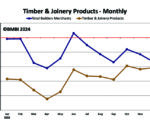Construction starts stall but surge in approvals points to brighter prospects
 UK construction started the year on a subdued note but a renewed surge in planning approvals suggests stronger growth ahead, according to new figures from industry analysts Glenigan.
UK construction started the year on a subdued note but a renewed surge in planning approvals suggests stronger growth ahead, according to new figures from industry analysts Glenigan.
The Glenigan Index for April, which covers the value of projects starting on site during the first quarter of the year, is flat on a year ago as activity struggles to keep pace with 2014 levels.
Residential starts remain unchanged on a year earlier, non-residential starts have dipped by 1% and civil engineering starts are up by a modest 3%. By contrast, the first quarter of 2014 saw activity rise by 22%, fuelled by a 33% increase in residential starts and a 20% rise in the non-residential sector.
However, Glenigan data points to a renewed surge in projects receiving detailed planning approval. During the first two months of 2015, approvals were up by 36% compared to a year earlier, with a marked 54% expansion in non-residential approvals.
Allan Wilén, Economics Director at Glenigan, said: “The overhang of last year’s relatively muted rise in approvals, coupled with some private sector clients potentially pursuing a ‘wait-and-see’ approach during the run up to the general election, may keep starts subdued into the second quarter.
“However this replenishing bank of prospective projects with detailed permissions bodes well for growth during the second half of this year, especially if a credible government emerges quickly from the aftermath of the election.”
Glenigan data hints at a slowing in construction specific investment over the last six months. Following strong and consistent growth since 2013 Q3, the pace of growth in the non-residential sector has dropped from 26% in the third quarter of last year to 5% during the final quarter. The rate of change has since turned negative, with a 1% decline in the first quarter of 2015.
With public sector work remaining largely flat over the period, it was commercial and industrial starts that fuelled growth. However these sectors are now dragging activity into negative territory. An expansion in hotel and leisure starts over the last three months was insufficient to offset falls in the industrial, office and retail sectors. The relatively mild 1% drop is due to a strong 18% expansion in education starts, which more than offset continued falls in health and community and amenity work.
Elsewhere in this month’s Index, residential starts have been flat, though this comparison is against a particularly strong base as starts rose by a third during the same period of 2014. The underlying value of civil engineering schemes rose by a modest 3%, with the utilities sector outperforming infrastructure.
An east versus west split emerged in the fortunes of the English regions during the first quarter of the year. Despite the UK as a whole seeing no improvement in starts, the North East, down through Yorkshire and the Humber, East Midlands, East and South East of England all saw marked rises relative to a year earlier.
By contrast the South West, West Midlands and North West of England saw starts drop, as did London. At £2.2 billion, the overall value of project starts in the capital in Q1 2015 is by some distance the largest total for any UK region, but this sum is down 13% on the first three months of last year. Among the other UK nations prospects similarly weakened, with starts down on a year earlier in Wales and Scotland and up by just 1% in Northern Ireland.
The monthly Glenigan Index is based on extensive research of every construction project starting in the UK over the previous three-month period, providing an indicator of developing activity and future output in the industry.











